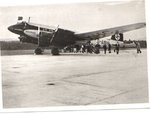- Thread starter
- #21
carman1877
Airman
- 51
- May 14, 2009
Found a great video showing a bomb run out to a Britsh Convoy. Really shows how they used guns as offensive weapons and not just defensive. Also shows the bomb bay in the gondola, along with the gunners in the gondola.
German Condor Bomber - Captured Fim Titled Long Range Bomber Over the Atlantic
German Condor Bomber - Captured Fim Titled Long Range Bomber Over the Atlantic


